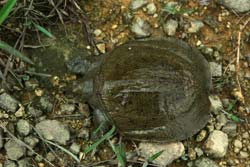Who am I – and if so, how many?DNA sequences reveal the true identity of Pelodiscus

Chinese softshell turtle Pelodiscus sinensis<br>© Markus Auer (Senckenberg)<br>
Traditionally it has been assumed that only the species Pelodiscus sinensis belonged to the genus examined. As a foodstuff, Chinese softshell turtles are the most economically important turtles in the world, with an annual trade volume of many hundreds of millions of specimens. The accompanying study is being published today in the “Journal of Zoological Systematics and Evolutionary Research”.
It is probably safe to say that none of the 300 million turtles that land on a plate in China each year are particularly interested to know the species to which they belong, but for scientists the discovery of different genetic lineages is of enormous significance. Due to its ease of breeding the turtle is often used as a model organism for embryological and physiological studies, so that a correct identification of the species is of paramount importance, not only in the fields of taxonomy and systematics.
Prof. Uwe Fritz, one of the Dresden authors of the study, confirms this: “While until now these turtles have been used as models in many scientific works, nobody actually knew what species they were. This led to considerable contradictions or non-reproducible results, because different species were used in different publications.”
The Chinese softshell turtle (Pelodiscus sinensis) is a strange looking animal: its shell is – as the name already suggests – soft, the long neck is flexible enough to allow the reptile even to see behind himself, and the trunk-like nose proves to be an excellent snorkel in shallow waters. Around the world there are more than 300 different turtle species, only 30 of which have a soft shell. Instead of an ossified shell, the softshell turtles, with a length of up to 30 centimetres, have a leather-like, flexible skin on their back and belly.
Together with his colleague Heiko Stuckas, Fritz examined the DNA of two 180-year-old softshell turtle shells from the Berlin Natural History Museum (Museum für Naturkunde). In 1834 the greatly shrunken and dried-out samples had served the German zoologist Arend Friedrich August Wiegmann as a basis for describing the species Pelodiscus sinensis.
Tiny pieces of tissue were removed from the shells by the Dresden researchers and parts of the genetic makeup of the turtles were defined with the help of the most up-to-date techniques. What is promising here is above all the analysis of the mitochondrial DNA, as these are present to a much greater degree compared to the DNA of the cell nucleus, thus minimising conservation problem.
Unfortunately, the attempt to gain DNA from the first turtle shell failed completely – the remnants of the animal were simply too old and too dried out. However, the second shell proved to be a great success for the research team! The analysis of the DNA sequences led to the conclusion that the genus Pelodiscus contains at least four and not – as previously believed – one species. For the first time, and with the help of the sequences from the Berlin sample, which is more or less the “original standard” for the species Pelodiscus sinensis, it could be clarified which of the four species is actually the “real” Chinese softshell turtle.
This finding is not only of great importance to the field of science; the turtles themselves can also benefit. At present all species that are collated under Pelodiscus sinensis have been placed on the red list of endangered species by the International Union for Conservation of Nature and Natural Resources (IUCN). However, some of the “newly discovered” species could actually be considered to be even more seriously endangered at present and may therefore enjoy greater protection.
In future, due to the results of the research, the different species will no longer be “lumped together” – at least by scientists – but rather can now be named precisely.
Publication: Stuckas, H. & Fritz, U. Identity of Pelodiscus sinensis revealed by DNA sequences of an approximately 180-year-old-type specimen and a taxonomic reappraisal of Pelodiscus species (Testudines: Trionychidae) (2011), J Zool Syst Evol Res doi: 10.1111/j.1439-0469.2011.00632.x
Contact:
Prof. Dr. Uwe Fritz
Senckenberg Naturhistorische Sammlungen Dresden
Abteilungsleiter Museum für Tierkunde
Königsbrücker Landstr. 159
01109 Dresden
Tel. 0351 795841 4326
Fax 0351 795841 4327
E-Mail: Uwe.Fritz@senckenberg.de
Press Office Senckenberg Gesellschaft für Naturforschung
Judith Jördens
Senckenberganlage 25
63065 Frankfurt/Main
Tel. 069-7542 1434
E-Mail: judith.joerdens@senckenberg.de
The research of life forms in their diversity and their ecosystems, climate research and geology, the search for past life and ultimately the understanding of the entire Earth-Life system – that is what the SENCKENBERG Gesellschaft für Naturforschung works for. Exhibitions and museums are the window to natural science, by which means Senckenberg shares current scientific results with the public and provides an insight into past ages and the diversity of nature.
Media Contact
More Information:
http://www.senckenberg.deAll latest news from the category: Life Sciences and Chemistry
Articles and reports from the Life Sciences and chemistry area deal with applied and basic research into modern biology, chemistry and human medicine.
Valuable information can be found on a range of life sciences fields including bacteriology, biochemistry, bionics, bioinformatics, biophysics, biotechnology, genetics, geobotany, human biology, marine biology, microbiology, molecular biology, cellular biology, zoology, bioinorganic chemistry, microchemistry and environmental chemistry.
Newest articles

Machine learning algorithm reveals long-theorized glass phase in crystal
Scientists have found evidence of an elusive, glassy phase of matter that emerges when a crystal’s perfect internal pattern is disrupted. X-ray technology and machine learning converge to shed light…

Mapping plant functional diversity from space
HKU ecologists revolutionize ecosystem monitoring with novel field-satellite integration. An international team of researchers, led by Professor Jin WU from the School of Biological Sciences at The University of Hong…

Inverters with constant full load capability
…enable an increase in the performance of electric drives. Overheating components significantly limit the performance of drivetrains in electric vehicles. Inverters in particular are subject to a high thermal load,…





















